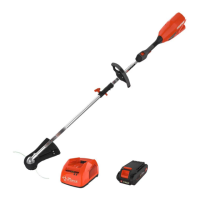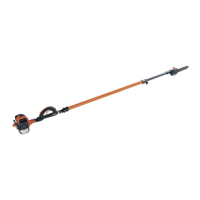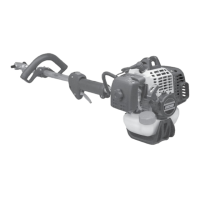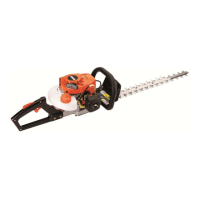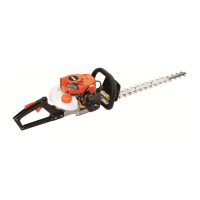DPAS-2100
9992223804740
© 12/2022 ECHO Incorporated
OPERATION
Reaction Forces
◆
The cutting attachment will continue to rotate even after the throttle is
released, maintain control of the unit until it has come to a complete
stop.
◆
Blade thrust may occur when the spinning blade contacts an object
that it does not immediately cut. Following proper cutting techniques
will prevent blade thrust.
◆
Blade thrust can be violent enough to cause the unit and/or operator
to be propelled in any direction, and possibly lose control of the unit.
◆
Blade thrust can occur without warning if the blade snags, stalls or
binds.
◆
Blade thrust is more likely to occur in areas where it is difcult to see
the material being cut.
Push or Pull - Kickout
During normal use, operating a brushcutter with a circular metal blade can
produce sudden strong reaction forces that are difcult to control. Strong
reaction forces can cause a loss of balance or loss of control of the equipment,
resulting in serious injury to operator and bystanders.
Understanding what causes these reactive forces may help you to avoid them,
and can help you to maintain control of the equipment if you experience a
sudden reaction during cutting. Reactive forces occur when the force being
applied by the cutting teeth of a blade meet resistance, and some of the cutting
force is directed back toward the equipment. The greater the cutting force or
the amount of resistance, the greater the reactive force.
Push and Pull Forces
Push and pull forces are reactive forces that push the
equipment directly toward the operator, or that pull the
equipment directly away from the operator. These forces
are the result of cutting on the sides of the blade. The
direction of the force depends on the side of the blade
being used, and the direction of blade rotation at the
point of contact. The reactive force is in the opposite
direction of blade rotation at the contact point, regardless
of where the contact is being made. These types of
reactive forces are also called “Blade Thrust.”
As shown in the illustration, a blade turning
counterclockwise will cause the equipment to pull away
from the operator if the point of cutting resistance is on
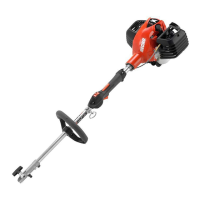
